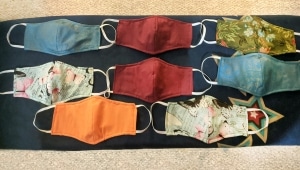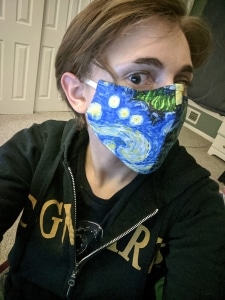It feels so long ago when I last wrote about domestic hobbies as play. It was indeed a different world—if we told our past selves what our lives look like now, we wouldn’t believe ourselves.
But what was true then is still true today: the calm attained when lost in the flow of an activity like sewing or knitting is a powerful and addictive, and a welcome respite from daily worries. The finished products of our craft are a testimony to the lives we have lived; the objects we create are an assurance that we were here and will remembered for a long time to come.
Rosa Inocencio Smith writes in “Getting Through a Pandemic with Old-Fashioned Crafts,” published on April 1, 2020 in The Atlantic:
To crochet, or to knit, or to block out an image in cross-stitch or needlepoint, is both to make something and to make sense of it, turning a slack piece of string into something with recognizable function and form. All of us amateur crafters alone in our rooms are filling our empty spaces, each shaping a single tenuous strand into something with strength and body. We are making something lasting out of solitude.
Creative pursuits also meet the need for community and belonging through social causes and charities, connecting the crafter to communities down the street or across the globe. Sewing and knitting were used to battle slavery and poverty; citizens on the home front of American wars used their skills to help soldiers on the front lines.
Today, there is a different kind of war. There are different kinds of soldiers on the front lines: medical workers, first responders, service industry workers fighting the invisible enemy of coronavirus and working tirelessly to get Americans much needed food, shelter, and medical care. The pandemic has created a shortage of PPE—personal protective equipment—that hospitals use to protect their workers from exposure to viruses and other contagions. Essential businesses are struggling to provide masks to protect their employees. Citizens have been encouraged or required by their state or local officials to wear cloth masks in public and are wondering where they will find them.
Enter the army of crafters and makers… and librarians!
 You don’t have to look far from the doors of The Strong to find these heroes and witness their creative superpowers. A Rochester data engineer, Coty Pastene, put a 3D printer to work and recruited other makers to make face shields for local health care workers such as her wife. Local fabric stores stepped up as well, providing instructions, material recommendations, and other resources to their customers. Sew Creative, located in Fairport, New York, sprang into action early to coordinate making and delivering masks to Rochester area healthcare staff.
You don’t have to look far from the doors of The Strong to find these heroes and witness their creative superpowers. A Rochester data engineer, Coty Pastene, put a 3D printer to work and recruited other makers to make face shields for local health care workers such as her wife. Local fabric stores stepped up as well, providing instructions, material recommendations, and other resources to their customers. Sew Creative, located in Fairport, New York, sprang into action early to coordinate making and delivering masks to Rochester area healthcare staff.
Librarians across the state have stepped up to do what they do best: put all of their resources to work for their communities. Everywhere 3D printers in libraries are working overtime, including Columbia University, and an inspiring partnership between Stony Brook University and Suffolk County libraries illustrates how much can be achieved by pooling resources: the public libraries have sent their 3D printers to a central “printer farm” to produce plastic headbands and Stony Brook’s iCreate lab creates the face shields.
 The Brian Sutton-Smith Library and Archives of Play’s own cataloger, Lindsey Barnick, has personally created more than 40 cloth face masks for friends and family since the museum closed to the public in March. As The Strong looks forward to welcoming guests into the museum again, Barnick will join her crafty coworkers in making masks for museum staff to keep everyone safe.
The Brian Sutton-Smith Library and Archives of Play’s own cataloger, Lindsey Barnick, has personally created more than 40 cloth face masks for friends and family since the museum closed to the public in March. As The Strong looks forward to welcoming guests into the museum again, Barnick will join her crafty coworkers in making masks for museum staff to keep everyone safe.
And you can count me as a recruit into this crafting army: after over a decade, I dug my weapon of choice out of my closet: I have a sewing machine and I’m not afraid to use it.
This is part four in Beth Merkle’s domestic hobbies series.
 Hours 10 a.m.–5 p.m. | Fri. & Sat. till 8 p.m.
Hours 10 a.m.–5 p.m. | Fri. & Sat. till 8 p.m.